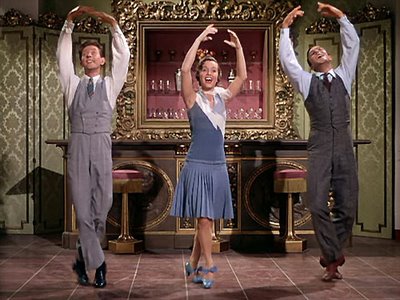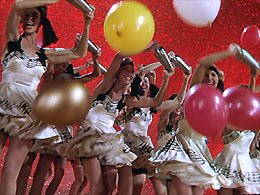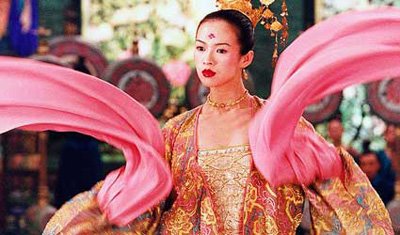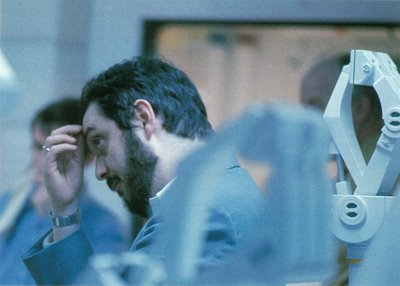
My film class at the prison watched Singin' in the Rain (1952). I initially wanted merely to discuss Technicolor and the changing aesthetic of the movies, especially American ones, as color--and eventually widescreen and one version or another of stereo or "surround" sound--became the norm by the late 1960s. But the more I thought about it, the more I realized that such exuberant, often garish, sometimes even jarring developments in the look and sound of films was less a response to audience appetite or market pressures--television--than it was a reflection of cinema's strongest inclination: toward "that which is unconscious," the dream-state triumphed first by the expressionists and then the surrealists/Dadaists. The musical and Technicolor--and after them widescreen and audio advances--were, at their best, mass-appeal manifestations of the Pleasure Principle, set in almost explicit conflict with the anxieties of film noir's insistence that life is a dream--about falling. The dancing bananas and toothy grins of Busby Berkeley, and later the aggressive athleticism of Gene Kelly, seemed to capture the giddy assertions of the ego, just as noir charted the fear-frozen withdrawal of the superego. (Good old Freud; as an analyst, he's almost dangerous; as an art critic, though, he's invaluable.)
 So how do we go from Un Chien Andalou's slit eyeball in 1929 to Gene Kelly and Donald O'Connor insisting that they gotta dance and be a clown, respectively? It's easier than you think: Watch Kelly's nonlinear approach to a dance number, as he shifts unexpectedly from tap to ballet to flat-footed clowning. And even more so, the frenzy of O'Connor's entire persona, literally from tip to toe an unchecked random-access pastiche-program of every involuntary tic and reflexive jerk, tumbled together like goofy fractals. When Dali and Bunuel assembled Un Chien Andalou, they agreed that no individual scene should have a logical connection to its predecessor, nor serve as a transition to the next. And although Singin' in the Rain seems to bow to the conventions of narrative, as boy gets/loses/gets girl, its insistence that it be a movie about making movies--it meta-ends with the cast starring in a movie called Singin' in the Rain--makes the movie turn inward, until it finds the dream-state, fulfilling wishes with Dali's sense of humor: This is chaos, to be sure, but of a flamboyant variety, goggle-eyed and self-conscious, aspiring to glory.
So how do we go from Un Chien Andalou's slit eyeball in 1929 to Gene Kelly and Donald O'Connor insisting that they gotta dance and be a clown, respectively? It's easier than you think: Watch Kelly's nonlinear approach to a dance number, as he shifts unexpectedly from tap to ballet to flat-footed clowning. And even more so, the frenzy of O'Connor's entire persona, literally from tip to toe an unchecked random-access pastiche-program of every involuntary tic and reflexive jerk, tumbled together like goofy fractals. When Dali and Bunuel assembled Un Chien Andalou, they agreed that no individual scene should have a logical connection to its predecessor, nor serve as a transition to the next. And although Singin' in the Rain seems to bow to the conventions of narrative, as boy gets/loses/gets girl, its insistence that it be a movie about making movies--it meta-ends with the cast starring in a movie called Singin' in the Rain--makes the movie turn inward, until it finds the dream-state, fulfilling wishes with Dali's sense of humor: This is chaos, to be sure, but of a flamboyant variety, goggle-eyed and self-conscious, aspiring to glory. I pressed all this upon my students, with handouts and lecture and those annoying-but-necessary pauses during the film to point out salient moments of sparkly insanity, graceful dream-soaring, and pounding assertion, as Kelly, O'Connor and Debbie Reynolds threw the furniture around and deconstructed the acts of making and viewing movies. I'm not sure I convinced them that Singin' in the Rain is hallucinogenic--I checked an online quote repository, and it reminded me that Dali said somewhere or other, "I don't do drugs. I am drugs"--but certainly, bathed in Techni-reds, greens, blues, fueled by the hardest-working feet in show business, Singin' serves as a reminder of Technicolor's doorway to a frisky ur-world, one whose atemporal shrugs shift its pastel sensibilities any which time it pleases--we also watched a few metrosexually costumed moments from The Adventures of Robin Hood (1938) (talk about yer time-defying reds, greens, and blues)--and echo in the movies' propelling arc toward the suspension of disbelief--we turned to scenes from House of Flying Daggers (2004) that were startlingly similar to Singin' in the Rain and The Adventures of Robin Hood, in their attention to the graceful but impossible flow of scarves--see the Echo Dance of Daggers and the Broadway Melody ballet of Singin'--and improbable forest flight-and-fight, whether in Robin Hood's staves and Tarzan-swings or Dagger's bamboo-top wire-fu.
I pressed all this upon my students, with handouts and lecture and those annoying-but-necessary pauses during the film to point out salient moments of sparkly insanity, graceful dream-soaring, and pounding assertion, as Kelly, O'Connor and Debbie Reynolds threw the furniture around and deconstructed the acts of making and viewing movies. I'm not sure I convinced them that Singin' in the Rain is hallucinogenic--I checked an online quote repository, and it reminded me that Dali said somewhere or other, "I don't do drugs. I am drugs"--but certainly, bathed in Techni-reds, greens, blues, fueled by the hardest-working feet in show business, Singin' serves as a reminder of Technicolor's doorway to a frisky ur-world, one whose atemporal shrugs shift its pastel sensibilities any which time it pleases--we also watched a few metrosexually costumed moments from The Adventures of Robin Hood (1938) (talk about yer time-defying reds, greens, and blues)--and echo in the movies' propelling arc toward the suspension of disbelief--we turned to scenes from House of Flying Daggers (2004) that were startlingly similar to Singin' in the Rain and The Adventures of Robin Hood, in their attention to the graceful but impossible flow of scarves--see the Echo Dance of Daggers and the Broadway Melody ballet of Singin'--and improbable forest flight-and-fight, whether in Robin Hood's staves and Tarzan-swings or Dagger's bamboo-top wire-fu. 
 We ended the class by going to "Jupiter and Beyond the Infinite" via 2001's final sequence. One of my students asked me if it was a silent film. Of course, this pleased me immensely--as it would have Kubrick--and allowed me to wax ecstatic about the loss of narrative line in everything we'd watched that morning, not reducing, but purifying film to its surreal elements. I'd wished I'd had handy some of Edison's "actualities," in which barely clad figures run and throw balls, divorced from cause and effect, atoms collected in their own hidden agendas, flickering at us with the illusion of purpose, while dedicated only to direct, untrammeled experience. But, like 2001's Dave Bowman, nobody around me saw how desperate the situation had become. I needed to take HAL's advice and sit down calmly, take a stress pill, and think things over.
We ended the class by going to "Jupiter and Beyond the Infinite" via 2001's final sequence. One of my students asked me if it was a silent film. Of course, this pleased me immensely--as it would have Kubrick--and allowed me to wax ecstatic about the loss of narrative line in everything we'd watched that morning, not reducing, but purifying film to its surreal elements. I'd wished I'd had handy some of Edison's "actualities," in which barely clad figures run and throw balls, divorced from cause and effect, atoms collected in their own hidden agendas, flickering at us with the illusion of purpose, while dedicated only to direct, untrammeled experience. But, like 2001's Dave Bowman, nobody around me saw how desperate the situation had become. I needed to take HAL's advice and sit down calmly, take a stress pill, and think things over.
No comments:
Post a Comment